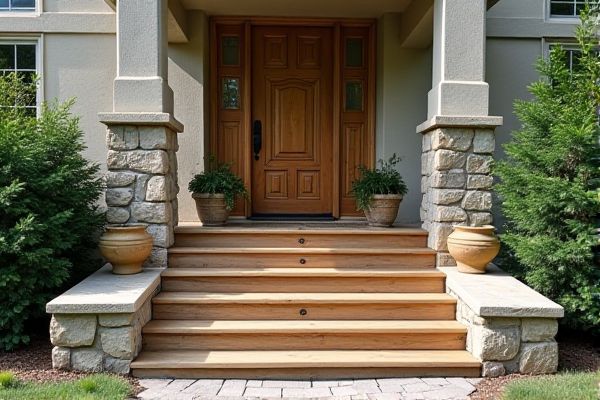
Stone steps offer exceptional durability and low maintenance, making them ideal for withstanding harsh weather and heavy foot traffic, while wood steps provide a warm, natural aesthetic but require regular upkeep to prevent rot and damage. Consider how your porch's style and maintenance preferences align with these materials--explore the rest of the article to determine which option best suits your home.
Table of Comparison
| Feature | Stone Steps | Wood Steps |
|---|---|---|
| Durability | Highly durable; resistant to weather and wear | Moderate durability; prone to rot and insect damage |
| Maintenance | Low maintenance; occasional cleaning and sealing | High maintenance; regular staining, sealing, and repairs |
| Cost | Higher upfront cost; long-term investment | Lower upfront cost; may require frequent replacement |
| Aesthetics | Natural, timeless look; variety of textures and colors | Warm, traditional look; customizable with paint or stain |
| Safety | Slip-resistant when textured; can be cold in winter | Can be slippery when wet; may warp or splinter |
| Installation | Labor-intensive; requires skilled craftsmanship | Faster and easier installation; DIY-friendly |
| Environmental Impact | Natural material; minimal processing | Wood sourcing impacts sustainability; treated wood may have chemicals |
Introduction: Choosing Between Stone and Wood Steps for Your Porch
Stone steps offer unparalleled durability and low maintenance, making them ideal for long-lasting porch designs that withstand weather and heavy foot traffic. Wood steps provide a warm, natural aesthetic with ease of customization and repair but require regular sealing and maintenance to prevent rot and weather damage. Selecting between stone and wood steps depends on factors like climate, desired style, budget, and long-term upkeep preferences.
Aesthetic Appeal: Stone Steps vs. Wood Steps
Stone steps offer a timeless, natural aesthetic that enhances the durability and elegance of your porch with varied textures and colors, creating a rustic or sophisticated look. Wood steps provide warmth and a classic charm, allowing for customizable stains and finishes that blend seamlessly with traditional or modern home designs. Choosing between stone and wood steps depends on your desired style, maintenance preferences, and the overall architectural appeal you want to achieve.
Durability and Longevity Comparison
Stone steps offer superior durability and longevity compared to wood steps, with natural resistance to weather, rot, and pests, often lasting several decades with minimal maintenance. Wood steps, while aesthetically pleasing, are prone to decay, warping, and insect damage, typically requiring regular sealing and replacement within 10-15 years. Choosing stone steps ensures a long-term investment with higher structural integrity and lower upkeep costs for porch applications.
Maintenance Requirements for Stone and Wood Steps
Stone steps require minimal maintenance, needing only occasional cleaning and sealing to prevent cracks and discoloration, making them highly durable and weather-resistant. Wood steps demand regular upkeep, including sanding, staining, and sealing to protect against rot, insect damage, and moisture warping. Your choice should factor in the time and effort you're willing to invest, as wood requires more frequent attention to maintain its appearance and structural integrity.
Safety and Slip Resistance Considerations
Stone steps offer superior slip resistance due to their textured, rough surfaces that provide better traction in wet or icy conditions. Wood steps, while aesthetically pleasing, can become slippery when wet or covered with moss, requiring regular maintenance or anti-slip treatments to enhance safety. Ensuring your porch steps have adequate slip resistance is crucial to prevent accidents and maintain a secure entryway year-round.
Cost Analysis: Upfront and Long-Term Expenses
Stone steps typically demand higher upfront costs due to materials and installation, but their durability reduces long-term maintenance expenses, making them cost-effective over time. Wood steps often involve lower initial investment but require regular sealing, painting, and repairs, increasing ongoing expenses. Your choice depends on budget priorities and willingness to manage maintenance efforts.
Installation Process: Stone Steps vs. Wood Steps
Installing stone steps requires precise groundwork, including excavation, leveling, and laying a solid base of gravel and mortar to ensure long-term durability and stability. Wood steps involve framing with treated lumber, securing stringers, and attaching treads and risers, which generally allows for quicker installation but may require additional measures to prevent moisture damage. Stone steps offer increased longevity and low maintenance, whereas wood steps provide ease of customization and faster assembly but need regular sealing and inspections for rot or pests.
Climate and Weather Impact on Step Material
Stone steps offer superior durability against extreme weather conditions, resisting moisture, temperature fluctuations, and UV exposure without warping or rotting, making them ideal for regions with heavy rain, snow, or intense sun. In contrast, wood steps require regular sealing and maintenance to prevent warping, cracking, and mold growth in humid or wet climates, but they provide better insulation and a warmer aesthetic in moderate environments. Homeowners in coastal or snowy areas benefit from stone's non-slip texture and resistance to salt damage, while those in dry, mild climates may prefer wood's natural appeal despite its higher upkeep demands.
Environmental Impact and Sustainability
Stone steps offer superior environmental benefits due to their natural durability and minimal maintenance, reducing waste and the need for frequent replacements. Wood steps, while renewable, may require treatment with chemicals that can harm ecosystems and often need more frequent repairs or replacement, increasing their environmental footprint. Choosing stone steps for your porch supports long-term sustainability by minimizing resource consumption and environmental disruption.
Best Applications: When to Choose Stone or Wood Steps
Stone steps are best suited for outdoor environments requiring durability, low maintenance, and resistance to weathering, such as garden paths, porches exposed to heavy rain, or areas with high foot traffic. Wood steps offer warmth and aesthetic appeal, ideal for covered porches or shaded areas where protection from moisture extends their lifespan and where customization and design versatility are priorities. Choosing stone is optimal for long-term investment and structural integrity, while wood steps are preferable when budget, ease of installation, and traditional design complement the home's architecture.
 homyna.com
homyna.com